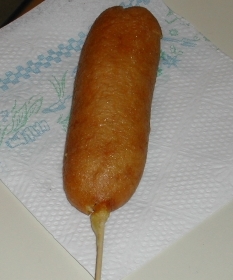In Australia, we call it the dagwood dog while in America they sometimes call it the corndog.
For years I’ve been told horrific stories about the contents of the sausage meat in dagwood dogs, but still found them delicious anyway.
When hot-dogs were first made, some producers would throw in soft-meat leftovers which may have included tasty things like noses, tongues, lips etc, but today, the hotdog sausage is much more carefully managed, especially in light of mad-cow disease.
Common hot dog ingredients include:
- Meat by-products and fat … lots of fat;
- Flavourings, such as garlic, paprika and salt … lots of salt;
- Preservatives, eg sodium erythorbate and sodium nitrite
So what are the meat by-products in the dagwood dog sausage anyway? Usually it is derived from pork or beef but is made of the meat slurry extruded from the last of the meat left on the animal. Leftovers are forced through a sieve and the meat is extracted, while the bone is left behind. Finally, the casing of a dagwood dog sausage is made from the small intestines of a sheep. It’s sounding better and better all the time isn’t it?
An American cancer study discovered that people who consumed a dagwood dog on a daily basis, increased their risk of colon cancer by 20%. So by all means, have a dagwood dog – once a year at the Ekka won’t kill you - unless of course you are a child. Statistics in America show that 17% of cases where a child has choked, the cause has been the dagwood dog.
An American cancer study discovered that people who consumed a dagwood dog on a daily basis, increased their risk of colon cancer by 20%. So by all means, have a dagwood dog – once a year at the Ekka won’t kill you - unless of course you are a child. Statistics in America show that 17% of cases where a child has choked, the cause has been the dagwood dog.
In Australia, the dagwood dog is extremely popular at our annual exhibitions or shows. The biggest show in the state of Queensland is affectionately known as the Ekka while it's official name is the Royal Queensland Show. For the first time in 2010, a healthy showbag option was made available to visitors at the show - a fruit showbag. But, the dagwood dog still remained one of the most popular items with around 200,000 consumed.
Health expert Graham Park has advised that the dagwood dog is very high in kilojoules and as long as you are willing to do a bit of jogging while at the Ekka, you can burn off what you have consumed. All you have to do is jog around the main arena at the showgrounds (which is 20,000m2) a total of eight times.
Health expert Graham Park has advised that the dagwood dog is very high in kilojoules and as long as you are willing to do a bit of jogging while at the Ekka, you can burn off what you have consumed. All you have to do is jog around the main arena at the showgrounds (which is 20,000m2) a total of eight times.
The first Ekka was held in 1876 and was primarily an agricultural show and attracted just 17,000 visitors. Today, the Brisbane Ekka runs for ten days and can attract anywhere between 400,000 and 600,000 people. ©
And now for a bit of historical fun, following are some photos of the Ekka in the past:
The copyright for these photos has expired, and the images were
made available through the John Oxley State Library in Brisbane.















No comments:
Post a Comment